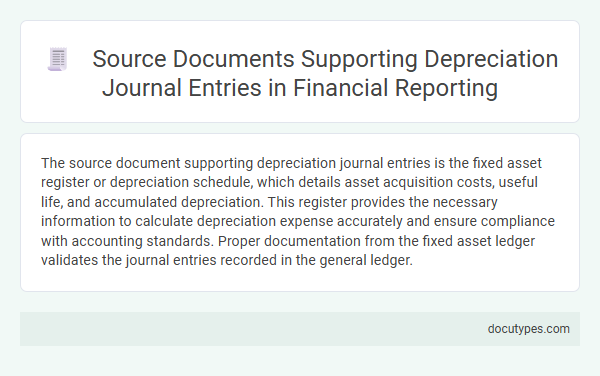The source document supporting depreciation journal entries is the fixed asset register or depreciation schedule, which details asset acquisition costs, useful life, and accumulated depreciation. This register provides the necessary information to calculate depreciation expense accurately and ensure compliance with accounting standards. Proper documentation from the fixed asset ledger validates the journal entries recorded in the general ledger.
Importance of Source Documents in Depreciation Reporting
Source documents such as purchase invoices, asset acquisition records, and depreciation schedules support depreciation journal entries by providing verifiable evidence of asset values and depreciation calculations. These documents ensure accuracy and compliance with accounting standards, aiding in transparent financial reporting. Your ability to maintain organized source documents strengthens the reliability of depreciation reports and audit trails.
Types of Source Documents for Depreciation
Source documents that support depreciation journal entries primarily include fixed asset registers and purchase invoices. These documents provide essential details such as asset acquisition cost, date, and useful life, which are necessary for accurate depreciation calculations.
Depreciation schedules and maintenance records also serve as important source documents. They help track the periodic allocation of asset cost over time, ensuring proper financial reporting and audit compliance.
Asset Purchase Invoices and Receipts
Source documents that support depreciation journal entries primarily include asset purchase invoices and receipts. These documents provide essential details needed for accurate accounting and asset tracking.
- Asset Purchase Invoices - These invoices record the cost and date of acquisition for fixed assets, serving as the initial basis for depreciation calculations.
- Receipts - Receipts validate the payment and ownership transfer of assets, ensuring the financial records match the physical assets.
- Supporting Documentation - Detailed descriptions and warranty information on these documents help determine the useful life and depreciation method.
You should maintain these source documents meticulously to ensure compliance and accuracy in your depreciation journal entries.
Asset Register and Inventory Records
Source documents are essential for accurate depreciation journal entries, providing the necessary data to calculate asset value reduction over time. The Asset Register and Inventory Records serve as primary references in tracking and supporting these entries within your accounting system.
- Asset Register - Contains detailed information on fixed assets including acquisition cost, purchase date, and useful life used for calculating depreciation.
- Inventory Records - Provide verification of asset existence and condition, ensuring depreciation is applied only to assets currently held.
- Supporting Documentation - Includes purchase invoices and maintenance records which validate the asset data recorded in the Asset Register and Inventory Records.
Capitalization Approval Forms
Capitalization Approval Forms serve as essential source documents supporting depreciation journal entries. These forms provide detailed records of asset acquisition, ensuring accurate capitalization of costs.
Your accounting team relies on these forms to verify the initial asset value and useful life before calculating depreciation. Proper documentation through Capitalization Approval Forms guarantees compliance with accounting standards and audit requirements.
Maintenance and Improvement Documentation
What source document supports depreciation journal entries related to maintenance and improvement? Maintenance and improvement documentation provides essential evidence for recording depreciation adjustments. These documents detail the costs incurred, ensuring accurate allocation of expenses over an asset's useful life.
Depreciation Schedules and Calculations
Depreciation schedules serve as the primary source document supporting depreciation journal entries by detailing the asset's cost, useful life, and accumulated depreciation. These schedules provide a systematic calculation framework, ensuring accuracy in recording periodic depreciation expenses. Accurate depreciation calculations rely on data from fixed asset registers and prior accounting records, which feed into the depreciation schedule used for journal entry validation.
Supporting Contracts and Lease Agreements
Source documents such as supporting contracts and lease agreements provide critical evidence for depreciation journal entries. These documents outline asset acquisition terms and usage parameters that justify the recorded depreciation values.
- Supporting contracts - Detail the purchase price, acquisition date, and asset specifications essential for calculating depreciation.
- Lease agreements - Define the leased asset's useful life and lease period, informing the depreciation schedule applied in accounting records.
- Compliance verification - These documents ensure depreciation entries align with contractual obligations and accounting standards.
Auditor’s Requirements for Depreciation Evidence
Source documents that support depreciation journal entries include fixed asset registers, purchase invoices, and depreciation schedules. These documents provide essential evidence for the calculation and recording of asset depreciation.
Auditors require detailed documentation to verify the accuracy and validity of depreciation expenses. You must present original purchase invoices and updated fixed asset registers showing asset acquisition dates and values. Depreciation schedules that outline the method, useful life, and accumulated depreciation are critical for audit compliance.
What Source Document Supports Depreciation Journal Entries? Infographic

